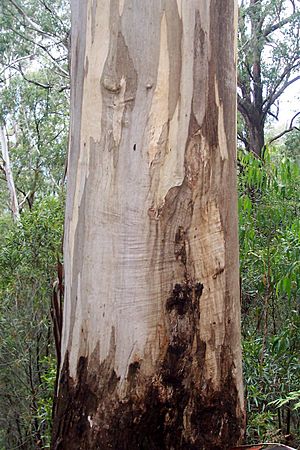Mountain grey gum facts for kids
Quick facts for kids Mountain grey gum |
|
|---|---|
 |
|
| Eucalyptus cypellocarpa in Deua National Park | |
| Scientific classification | |
| Genus: |
Eucalyptus
|
| Species: |
cypellocarpa
|
The Mountain Grey Gum (scientific name: Eucalyptus cypellocarpa) is a tall forest tree. People also call it the mountain gum, monkey gum, or spotted mountain grey gum. This tree grows only in southeastern Australia. It has smooth bark and can grow very straight.
Its adult leaves are quite large and shaped like a spear or slightly curved. The tree produces white flowers from buds that grow in groups of seven. Its fruit usually looks like a cylinder or a small barrel.
Contents
What the Mountain Grey Gum Looks Like
The Mountain Grey Gum is a very tall tree. It can grow to be about 50 to 65 meters (164 to 213 feet) high. This tree has a special woody swelling at its base called a lignotuber. This helps the tree regrow if it gets damaged, for example, by a bushfire.
The bark of the Mountain Grey Gum is smooth. It can be white, grey, or yellowish. The bark peels off in long strips, like ribbons.
Leaves and Flowers
Young Mountain Grey Gum plants have stems that are square. Their leaves are attached directly to the stem without a stalk. These young leaves are shaped like a spear, a heart, or an egg. They are about 45 to 120 millimeters (1.8 to 4.7 inches) long.
Adult leaves are different. They are shiny green on both sides. They are shaped like a spear or are slightly curved. These leaves are much longer, about 90 to 305 millimeters (3.5 to 12 inches) long. Each adult leaf has a stalk called a petiole, which is about 12 to 32 millimeters (0.5 to 1.3 inches) long.
The tree's flower buds grow in groups of seven. They are found where the leaf meets the stem, a spot called the axil. These groups of buds grow on a main stalk called a peduncle, which is about 8 to 22 millimeters (0.3 to 0.9 inches) long. Each individual bud might also have a tiny stalk, or pedicel, up to 7 millimeters (0.3 inches) long.
When the buds are ready to open, they are green to yellow. They are oblong or oval-shaped, about 8 to 11 millimeters (0.3 to 0.4 inches) long. Each bud has a cap called an operculum, which is cone-shaped or looks like a beak.
The Mountain Grey Gum flowers are white. They bloom at different times of the year, usually from January to June and again from October to November.
Fruit
After flowering, the tree produces fruit. The fruit is a woody capsule. It is usually shaped like a cylinder or a barrel. Sometimes, it can be cup-shaped or like half a sphere. The fruit is about 5 to 10 millimeters (0.2 to 0.4 inches) long and wide. Like the buds, the fruit can be attached directly or have a small stalk up to 6 millimeters (0.2 inches) long.
How the Mountain Grey Gum Got its Name
The Mountain Grey Gum was officially named in 1962. An Australian botanist named Lawrie Johnson gave it its scientific name, Eucalyptus cypellocarpa. He found the first example of this tree, called the type specimen, near Mount Wilson in New South Wales.
The name cypellocarpa comes from ancient Greek words. Cypellum means "cup," and carpos means "fruit." This name refers to the cup-like shape of the tree's fruit. The correct ancient Greek word for "cup" is kypellon.
Where the Mountain Grey Gum Lives
The Mountain Grey Gum grows in New South Wales and Victoria, which are states in Australia. It likes to grow in wet sclerophyll forests. These are forests where the trees have hard, tough leaves. You can often find them in valleys and on the sides of hills.
This tree grows from areas near the sea up to about 1200 meters (3,900 feet) high. It prefers places that are cool to warm and humid. It needs about 700 to 1300 millimeters (27 to 51 inches) of rain each year. The temperature in these areas usually ranges from -2 to 31 degrees Celsius (28 to 88 degrees Fahrenheit).
In New South Wales, you can find it in wet forests south of Tamworth. In Victoria, it is common in the southeast, including places like the Black Range, Grampians, and Pyrenees.
See also
 In Spanish: Eucalipto gris de montaña para niños
In Spanish: Eucalipto gris de montaña para niños

